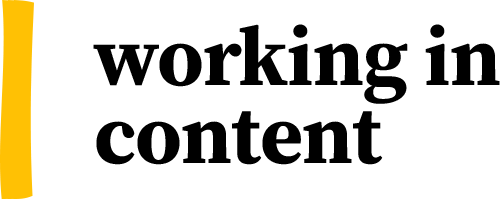On this page:
- Career history, at-a-glance
- How Tom got a content role at IBM
- A sideways step into UX design
- Forming a community of practice
- Working as IBM’s Content Design Lead
- Introducing more formal processes around content
- The importance of collaboration
- Training and development opportunities at IBM
- Achieving career progression at IBM
- Applying for a content design role at IBM: advice on how to prepare
- Tom's quick-fire recommendations
- Tom Waterton: Further reading
Tom Waterton is a content designer and experienced UX designer who has spent more than a decade working at global computing giant, IBM.
We chatted with Tom about what it’s like to work in content for such a massive tech corporation, how ‘content’ has achieved a new level of importance within his company, and his advice on applying for content roles at IBM.

Career history, at-a-glance:
![IBM logo]() IBMContent Design LeadJanuary 2019 - present
IBMContent Design LeadJanuary 2019 - present![IBM logo]() IBMContent DesignerAugust 2016 - January 2019 (2 years, 6 months)
IBMContent DesignerAugust 2016 - January 2019 (2 years, 6 months)![IBM logo]() IBMContent Team ManagerJuly 2015 - July 2016 (1 year, 1 month)
IBMContent Team ManagerJuly 2015 - July 2016 (1 year, 1 month)![IBM logo]() IBMContent EditorJuly 2013 - July 2015 (2 years, 1 month)
IBMContent EditorJuly 2013 - July 2015 (2 years, 1 month)![IBM logo]() IBMUX DesignerJuly 2011 - July 2013 (2 years, 1 month)
IBMUX DesignerJuly 2011 - July 2013 (2 years, 1 month)![IBM logo]() IBMTechnical WriterApril 2010 - July 2011 (1 year, 3 months)
IBMTechnical WriterApril 2010 - July 2011 (1 year, 3 months)
How Tom got a content role at IBM
Tom studied English at university and professes to have always enjoyed reading and writing. After graduating in 2003, he had a few short-term jobs and then found himself, quite accidentally, working on a large IT project at the University of Southampton. Part of this role involved using Cognos (a business intelligence application) and so Tom unwittingly became an IBM customer.
“I was invited as a customer to an IBM product roadshow event that was happening at their software labs in Hursley, Hampshire. I was already considering a job change, and as I lived locally, I thought I’d look into them as a potential employer, and see what job openings they happened to have.
“At the time, they only had a graduate scheme where the openings were either for software developers (which I wasn’t) or technical writers — which I thought I could probably do.
“I was already doing a fair bit of writing at the time, and after successfully completing their application process, I joined them as a technical writer in 2010; initially working on product documentation.
“When I look back, although I didn’t stay writing product docs for very long, I'm really pleased that I had that initial experience and that I know that world first-hand, as I still work with many colleagues who produce our products docs.”
Tom soon realised that one of the nice things about working for such a large organisation is that you can move around fairly easily into different jobs without having to leave the company. In fact, in his 11 years at IBM to date, Tom’s worked in no less than six different roles.
A sideways step into UX design
Just over a year later, Tom had switched from being a technical writer to being a UX designer.
“What attracted me most to the UX design role was the prospect of having more influence on how the product was designed and therefore more impact on the experience that customers would have using the product.
“I wasn’t trained in UX design, but thankfully my manager at the time saw my enthusiasm and took a chance on me. For the next year or two, I immersed myself in the world of UX design. Soon after this, IBM started investing heavily in design at a company wide level and brought in a couple of thousand formally trained designers.
“This was all part of a significant transformation that the company embarked upon to help them become a much more user-centred, design-led organisation.
“Hiring in lots of fresh design talent and helping existing staff learn about and adopt design thinking were the first steps, but in order to really scale design and achieve consistency across our many portfolios, we then needed to develop a robust design system.
“So fast forward a few years and we now have something called Carbon, which is a mature open-source design system. This has been really significant for us as it means that individual teams don’t have to keep reinventing the wheel, in terms of common design components and patterns. Instead, they can pick up and use high-quality design assets that also help us deliver consistent user experiences across our many offerings."
The nature of Tom’s current role as Content Design Lead means that he gets involved with a multitude of different projects, with his contribution revolving mainly around offering content guidance to design colleagues working across several portfolios.
“This can involve working with teams as they plan their information architecture, contributing to terminology discussions, or providing guidance on action buttons, navigation labels, or error messages."


Forming a community of practice
“While IBM did a great job at bringing in lots of UX designers, visual designers and user researchers, initially there was little investment in content design.
“IBM has always had content professionals working in marketing or writing product docs, but in the early days of our design transformation, there were few of us with content skills working on the in-product experience.
“However, over time, I gradually got to know a few other content designers scattered across the company. Like me, they were typically the only content designers in their part of the business, and so while it was an exciting, pioneering time, I think we also each felt quite isolated in those early days.”
This was when Tom and another early content design hire, Maranda Bodas, decided to start holding regular meetings to help content designers at IBM connect, share ideas and resources, and further develop their discipline.
“At our first meeting back in 2018 there were just 7 of us, but numbers began to swell month by month as more people heard about our community of practice and today we typically have 50-80 people attend our monthly meetings, and there are over 500 people in our active Slack channel.”
To find out more about how Tom, Maranda, and others helped to establish a thriving community of practice for content design at IBM, take a look at this article, which talks all about it.
Tom is a pleasure to work with. He designs experiences with words, the right ones, the proper ones, the just enough ones. The result is a better engagement and dialogue with the reader or user of the tool, article or product he’s involved in.
source: LinkedInWorking as IBM’s Content Design Lead
Tom’s current role is a broad one. He works in a business unit that has over 700 designers working on a large variety of cloud and cognitive enterprise software products.
“I'm the Content Design Lead, so I'm not assigned to any single product. My responsibilities include providing enablement materials for our designers and developers. The idea being to help everyone improve their skills and awareness around content, which is important as most of our product teams don’t have a dedicated content designer.”
“I also contribute to an ongoing cross-IBM initiative looking to further develop our content maturity and encourage greater collaboration between the different content professionals that we have (including those working in marketing, design, product docs, training, and support). I also mentor some of our newer content designers.”
Introducing more formal processes around content
Tom says that one of the most significant things his organisation has done in the last few years is to introduce formal product release reviews — what they call ‘Design and User Experience reviews’.
Historically, as IBM was an engineering-led company, it would often be the case that, with product deadlines approaching, features and functionality would be prioritised over user experience improvements — which included fixing any content and visual design issues.
“You only have a finite amount of engineering resource, and in the past, the result was often that products would be released with various parts of the user experience (including the content) not being as good as we’d want them to be, as all effort had gone into delivering technical functionality.
“But IBM creating a Design org that is a peer of Engineering has had a massive positive impact. Now, every time there's a release coming up, each product has to go through one of these formal reviews. It’s been a game-changer because what happens now is that the Vice President of Design at IBM or another senior design leader will be hosting each Design and UX review meeting.”
Tom describes the scene: everyone who has been involved in the product release will be on the call. The quality of the user experience is then assessed in real-time by the VP, who carries out some trials in front of everyone as though he were the end user — attempting to complete some common user goals. At the same time, a panel of senior designers will be assessing the experience.
“We have different people looking out for different things whilst all that’s happening. So some people are there to look specifically at the content within the product, others at the ‘getting started’ side of the experience, and others at the visuals, etc.
“It’s great because it’s all now part of the formal process, which includes a report being generated that contains all of the issues that were identified. The product team is then expected to factor in resolving these design and usability issues as part of their planning for their next release, which means that the quality of our products from a user experience perspective is improving all the time.”
The importance of collaboration
Tom can recall several instances when getting the relevant people from different departments working directly together significantly helped change the way content was worked on. By forming ‘content communities,’ that brought together all relevant stakeholders for a particular offering, teams were able to start thinking more holistically about the end-to-end content journey that our customers experience.
“The mindset shifts from ‘what piece of work do I need to deliver’ to ‘as a content community, how can we improve the overall experience?’ and basically, the simple answer very often was that there needed to be much better collaboration between disciplines and teams.”
One particular example Tom can remember involved a meeting of 15 people who had all worked on the same product but in different disciplines. They were based in many different locations and therefore didn’t all know each other.
The first thing was to bring everyone together in a series of group meetings. The team knew that their end-to-end content was inconsistent, so Tom facilitated a simplified content audit exercise.
“Instead of conducting a super detailed content audit in a spreadsheet, as content strategists might usually do, I wanted the exercise to be really visual. So we all started looking at the different assets IBM were providing to customers for this product, and we’d screenshot each of them and put them on this huge mural board.
“Pretty early on, it became clear to everyone that these assets not only had different visual styles but that there were also inconsistencies in the language used and in how we were describing the product and its value to our customers.“

Following this, each asset was reviewed in detail, with Tom and his colleagues examining the content and answering questions such as:
-
Who is this resource really aimed at?
-
What stage of the user journey does this content serve?
-
Is the content up-to-date?
-
How does this piece fit into the broader end-to-end experience?
IBM like to consider the different discrete stages of the user’s overall journey:
Discover > learn > try > buy > get started > use > get help > expand > end use
The collaborative content review ended up uncovering that plenty of content existed around stages such as ‘learning about the product’ and ‘getting help’, but that there wasn’t as much for some of the other stages of the user journey.
“That helped us with future work planning as it became evident which parts of the user journey were most in need of fresh content.
“We created an internal wiki and said, ‘look, every time someone goes to write about this product, instead of them creating some new strapline text about what it is and what it does, let's agree together as a group on what the common messaging should be. We did the same with product artwork, terminology, social media templates, and references.’
“As time progressed, people worked more and more collaboratively, and everyone involved felt pleased with what we'd achieved; both as a group, and in terms of what we were delivering to the market.”
Training and development opportunities at IBM
According to Tom, IBM actively tries to help people on their career path. And because IBM is such a large organisation, fortunately, there's quite a lot of investment in providing training. The organisation also likes to leverage the knowledge and expertise of their in-house experts for the benefit of other employees’ professional development.
“We have a whole portal for learning and it’s used across the company. We have some pretty smart people at IBM including various industry-leading experts, in all sorts of fields. Many of them regularly provide training opportunities through internal workshops and courses they themselves have produced.”
Tom says that IBM encourages all employees to spend at least 40 hours a year on training and educational opportunities. The caveat is that the onus is generally on the individual to drive their own professional development.
“My own expectation is that almost everyone will be spending some time — a few hours each month certainly — on upskilling themselves and investing in their own personal development.”
"If you’re working at IBM and you have enough ‘get up and go’ and there’s something you want to spend some time on, you'll rarely be told ‘no, you can't do that."
Achieving career progression at IBM
The design organisation that Tom works in is a fairly new part of the business and has enjoyed a huge amount of investment in recent years. This has included the formation of an official career framework for designers (historically, this had only ever existed for software engineers).
“I guess, in simplistic terms, progression in my area is linked quite heavily with ‘sphere of influence.’
“When we bring someone in at entry-level, the expectation is that they’ll be learning their craft and building up their experience for a while, but they’re likely to move up after showing they can demonstrate their ability to drive things and influence others in their product team.
“And perhaps then they’ll move up again to a more senior role if they can show they are influencing others outside of their immediate product team.”
When it comes to performance reviews, these occur once a year. And, just as in most companies, reviews are not explicitly tied to an opportunity for a promotion. Instead, an employee will work with their manager to consider the next steps for their career, and whether there are areas they need to work on in preparation for a move upwards.
“It’s really about making a plan for building that experience and evidence so that they can eventually request that promotion. It's about taking on initiatives and driving things forward yourself; taking on new responsibilities and leading on things.
“There are always lots of opportunities to get involved in projects; whether they’re directly tied to your main job deliverable or projects that help further develop a technology or discipline or craft, or that help the community.
“Whilst we all have our core work to do and some guidance to follow, I think IBM also want us to think outside the box, to explore new ideas, and to get stuck into interesting side projects that help us grow and further develop our skills.”
Tom has always shown a keen interest in technology, and been remarkably quick at picking up technical details even though he doesn't have an engineering background. He is very detail focused and has strong organisational and leadership skills: his meetings are very effective, and motivating a team just comes naturally to him. Overall his approach to things is calm and levelled. Whilst Tom is very polite and friendly, he does make sure that his view is well presented and understood. As a team player, he will always back the teams decision.
source: LinkedInApplying for a content design role at IBM: advice on how to prepare
Perhaps unsurprisingly, IBM would expect to see some kind of portfolio from candidates, but for them, it’s not just about the end result in a portfolio of work. They’re also interested in the candidate’s journey of how they ‘got there’ in that project or piece of content work.
“We’d want to see someone being able to articulate the journey they went on and answer questions such as:
Why did you come up with these particular words?
What was the process you followed, and where did you start?
What alternatives did you consider?
What did you learn as you were doing this work?
“We’d very much be looking for the thought process that they followed and what led them to the final deliverable.”
In terms of the qualities IBM might be looking out for in candidates, Tom says that he’s a big believer in curiosity, but also in not tying yourself too rigidly to any single tool, technology or process.
“If I was hiring a content designer, over and above familiarity with current tools and processes, I’d be looking for someone who shows evidence that they are constantly questioning how they can help and add value to the user in a given context — even if that means doing things in a different way to how they are currently done.
"The best content designers I’ve worked with are constantly thinking about who the user is, what goals the user has, and then how we can best help them to achieve those goals."
When it comes to the ‘soft skills’ needed by content designers, Tom thinks that you have to be fairly bold, and not only be prepared to always show up with your opinions and expertise, but be prepared to explain it all to others too.
“I say that not because you're likely to get a hostile reception at IBM, but because, in reality, things are often frantic and you could be working with very busy teams that are already trying to get loads of stuff done.
“In my experience engineers, product managers, and other designers all generally respond positively when someone turns up and says, ‘I've got some expertise in content and I've had a look at this. What I would recommend is something more like this because of these reasons.’
“If you do that, you’ll probably find that they’ll say, ‘thanks, that’s really helpful, we’ll take that away and apply it’ — but it does require the confidence upfront to be able to do that; especially if you are working with more senior colleagues.
“If you join as a recent grad, it can be somewhat intimidating when you are first assigned to a product team. You’ll often be interacting with fairly senior architects and engineers but if you can articulate your views well, and back them up with some evidence or a coherent explanation, then people will tend to trust you and your expertise as a content professional.”
Tom’s quick-fire recommendations
What advice would you give someone who is considering a switch to a content design or UX writing career?
“I think I’d emphasise that ‘collaboration’ is a big part of these roles if you join a large company. The ability to form lots of positive working relationships is really important.
“These are not roles where you sit alone at a desk, get handed some asset, and then asked to improve the wording. In fact, that picture of a solitary writer largely working on copy on their own is very misleading. In a big tech company like IBM, you’ll be working with lots of different people in meetings and calls, possibly on various different projects, where things can and will change a lot day-to-day.
“Another thing we look for is curiosity. Being able to demonstrate that you have this kind of trait is definitely something that would impress us.
“Thirdly, ideally you’d be able to show some experience of user testing of some content. Or, if you haven't had the chance to conduct any user testing yet, we’d look for you to at least be able to articulate what areas of a design you would like to test, why you chose those aspects, and how you might go about testing them.”
Which industry professionals should people be following right now on Twitter?
I’ll take the opportunity to mention some fellow Brits doing some great content work:
 Laura Robertson Co-founder, @contentiousltd. Content strategist on a mission to make the internet more human. Lover of lower case. Boulderer. Snowboarder. Baker.Follow @laurazoee
Laura Robertson Co-founder, @contentiousltd. Content strategist on a mission to make the internet more human. Lover of lower case. Boulderer. Snowboarder. Baker.Follow @laurazoee Julius Honnor Content strategy and digital. Co-founder, @contentiousltd. Co-chair, @digitalcharity. Author, editor, photographer. Dartmoor-born east London inhabitant.Follow @juliushonnor
Julius Honnor Content strategy and digital. Co-founder, @contentiousltd. Co-chair, @digitalcharity. Author, editor, photographer. Dartmoor-born east London inhabitant.Follow @juliushonnor Rachel McConnell Content ops @bt_uk, co-founder of @Leadwithtempo. Previously @DeliverooDesign and @Clearleft. Author of Why you Need a Content Team.Follow @Minette_78
Rachel McConnell Content ops @bt_uk, co-founder of @Leadwithtempo. Previously @DeliverooDesign and @Clearleft. Author of Why you Need a Content Team.Follow @Minette_78 Amy Grinstead Content designer, content strategist and writer. Currently @Nordea, previously @RNID, @DfE_DigitalTech, @EtchUKFollow @ContentCPH
Amy Grinstead Content designer, content strategist and writer. Currently @Nordea, previously @RNID, @DfE_DigitalTech, @EtchUKFollow @ContentCPHWhich three books would you recommend people read this year?
“I’m a real bookworm, so I’m always reading. I read a lot of novels, but I also try to challenge myself to regularly read some non-fiction as well. The three books I recommend here are not ‘content books’ per se, but I found each of them to be incredibly insightful, and I think any content or design professional would be able to take a lot from them.”
 Thinking, Fast and Slow
Thinking, Fast and SlowSystem 1 is fast, intuitive, and emotional; System 2 is slower, more deliberative, and more logical. The impact of overconfidence on corporate strategies, the difficulties of predicting what will make us happy in the future, the profound effect of cognitive biases on everything from playing the stock market to planning our next vacation―each of these can be understood only by knowing how the two systems shape our judgments and decisions.
This book is all about understanding our own and other people’s biases, better.
— Tom Waterton Factfulness: Ten Reasons We're Wrong About The World - And Why Things Are Better Than You Think
Factfulness: Ten Reasons We're Wrong About The World - And Why Things Are Better Than You ThinkThe international bestseller, inspiring and revelatory, filled with lively anecdotes and moving stories, Factfulness is an urgent and essential book that will change the way you see the world, and make you realise things are better than you thought.
This is a short, but very inspiring read. It highlights over and over again how many of the things we believe to be true about the world do not actually line up with the data we have available. And in many cases, the reality is actually a lot more positive than we tend to assume.
— Tom Waterton The Lean Startup: How Today's Entrepreneurs Use Continuous Innovation to Create Radically Successful Businesses
The Lean Startup: How Today's Entrepreneurs Use Continuous Innovation to Create Radically Successful BusinessesThe Lean Startup approach fosters companies that are both more capital efficient and that leverage human creativity more effectively. Inspired by lessons from lean manufacturing, it relies on “validated learning,” rapid scientific experimentation, as well as a number of counter-intuitive practices that shorten product development cycles, measure actual progress without resorting to vanity metrics, and learn what customers really want. It enables a company to shift directions with agility, altering plans inch by inch, minute by minute.
This book changed the way I approach things. It’s all about being truly, radically customer-centred. That is, whenever you think you have a good idea, very quickly turn it into a hypothesis that you can test. It’s also about prototyping, iterating, shortening the feedback loop, building an MVP (minimum viable product); and asking the five ‘whys.
— Tom WatertonAre there any content-related communities you are part of that you’d recommend others join?
“Over the last year or two, I’ve really been trying to be more present and focus on one thing at a time more with fewer distractions, so I’ve not been engaging so much in online communities. I guess I’m lucky that there is a good, active content community within IBM that I already benefit from. But, I do still read several content newsletters each week, issued by communities such as UX Writers Collective (their newsletter is called The Dash).”
Is there a particular site or product that you think does content particularly well?
"The UK Government site (GOV.UK) run by the Goverment Digital Service (GDS) team does a fantastic job of presenting a huge amount of inportant information clearly and concisely.
“I also love the fact that they are very specific about the user need for a given page.”















